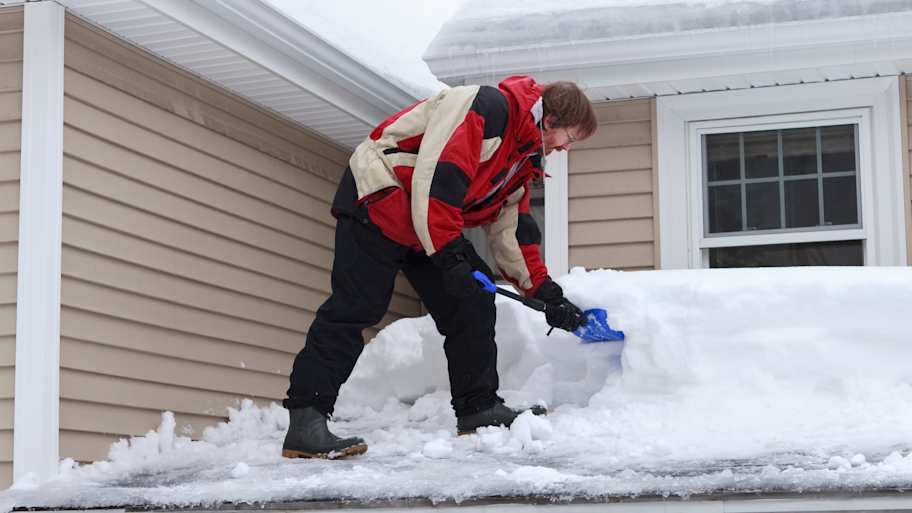
Discover the average roof heating cable installation cost, key price factors, and how to budget for your project. Learn how to save and what to expect.
Avoid a meltdown with our snow load calculator


A roof can typically hold 20 lbs. of snow per sq. ft.
Multiply the snow’s density and depth to figure out how much snow your roof can hold.
Removing snow from a roof is a dangerous job that’s best left to a pro.
You’re in the middle of a blizzard when an uncomfortable thought crosses your mind: How much snow can my roof hold? In most cases, a roof can support up to 4 feet of fresh powder—but it can’t hold as much old snow or ice, which are denser and heavier than new snow. This snow load calculator can help you better understand your roof’s limits and prevent snow from damaging your roof.
There are multiple factors that affect how much snow your roof can hold, including the type of snow, your roof’s material, and your roof’s pitch. Generally speaking, though, a roof can support 20 pounds of snow per square foot.
However, not all types of snow weigh the same. For example, it takes about 4 feet of fresh snow to amount to 20 pounds, but it only takes 2 feet of old, packed snow or 1 inch of ice to weigh that much. Here’s how much snow a roof can hold, depending on the type of snow:
| Type of Snow | Maximum Snow Load |
|---|---|
| Fresh | 4 ft. |
| Old or settled | 2 ft. |
| Mixture of fresh and settled | 2-3 ft. |
| Ice | 1 in. |
To determine how many total pounds of snow your roof can hold, you’ll need to know the square footage of your roof. Here are some common roof sizes and their maximum snow loads:
| Roof Size in Square Feet | Maximum Snow Load in Pounds |
|---|---|
| 1,000 | 20,000 |
| 1,250 | 25,000 |
| 1,500 | 30,000 |
| 1,750 | 35,000 |
| 2,000 | 40,000 |
| 2,250 | 45,000 |
| 2,500 | 50,000 |
| 2,750 | 55,000 |
| 3,000 | 60,000 |
To estimate your roof’s snow load, you’ll need to know the approximate density of the snow, as well as its depth. Once you have those numbers, you can plug them into the following formula:
Snow Load (in pounds per square foot) = Snow Density (in pounds per cubic foot) x Snow Depth (in feet)
For example, let’s say you have 2 feet of fresh snow on your roof. Since fresh snow ranges from 3 to 5 pounds per cubic foot in density, your roof’s snow load would be 6 to 10 pounds per square foot.
Heads up: This is a simplified snow load formula to calculate the snow load on a flat roof. It doesn’t account for a roof’s pitch. However, even if you have a steep roof, you can still use the formula. Just keep in mind that your actual snow load will likely be less than what you calculate with the formula since snow naturally slides off steeper roofs (but piles up on flat roofs).
Understanding your roof’s snow load will help you figure out when to remove snow from your roof before it gets damaged. But first, you’ll need to determine the snow’s density and depth. Here’s how to do that.
You don’t have to calculate the snow’s density yourself. Instead, you can use the following information to estimate its density based on the type of snow.
| Type of Snow | Average Density in Pounds Per Cubic Foot |
|---|---|
| Fresh | 3–5 |
| Old or settled | 12–26 |
| Ice | 51–58 |
Follow these steps to find the total snow depth at your home:
Find a flat area of ground with little or no grass. Alternatively, you can use a flat surface, like an outdoor table or deck.
Push a yardstick down into the snow until it hits the ground.
Measure the snow depth to the nearest tenth of an inch.

Roofs and ladder rungs can get extremely slippery when it snows, so never try to climb onto your roof to remove snow. Instead, your safest option is to hire a snow removal company. On average, professional roof snow removal costs around $200 to $700, depending on the size of your roof, snow depth, and other factors.
If you’re determined to clear snow from your roof without hiring a professional, you can use a roof rake. Just make sure to watch out for falling snow and ice and take regular breaks so you don’t overexert yourself.
From average costs to expert advice, get all the answers you need to get your job done.

Discover the average roof heating cable installation cost, key price factors, and how to budget for your project. Learn how to save and what to expect.

Should I remove snow from my roof? This is a common question for homeowners during the colder months. Find out when and how to tackle the job safely this winter.

They’re pretty in the winter sunshine, but are icicles bad for your roof? Learn whether you should worry about ice buildup and icicles hanging from your roof.

In areas that see heavy snowfall, understanding how to install snow guards on a metal roof is important for protecting people, property, and the roof itself.

Ice dams can cause roof and water damage and even structural damage to your home. Learn what causes them and how to prevent them to avoid property damage.

It’s a common myth that gutters cause ice dams, but any roof with snow on it can form ice dams. Learn how to protect your roof this winter.